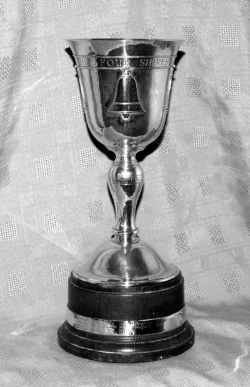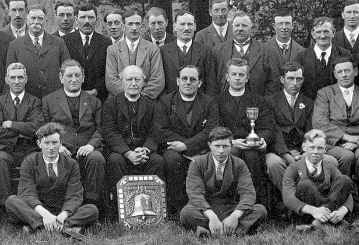A hundred years ago the Reverend Spencer Jones* was the Rector of Batsford with Moreton-in-Marsh. He became Rector in 1887** and remained Rector for over 40 years***. In his later years he was assisted by the Revd. Edward Spencer Jones (whom I believe was his son****), who was curate from 1925. Members of the Four Shires Guild remember Spencer Jones because he presented the Guild with a cup (The Spencer Jones Cup), to be given to the winning team at a striking competition.
Spencer Jones was an Anglo-Catholic and was frequently referred to as Father Jones. He was the author of three books, The clergy and the Catechism
(1895), England and the Holy See
(1904) and Our Lord and his lessons
(1907). He was prominent in putting forward the view that there should be unity between the various churches and he felt that there should be union between the Roman Catholic and Anglican churches. He is credited with starting the Week of Prayer for Christian Unity along with the Revd Lewis T Wattson, Rector of St John's Episcopal Church in Kingston, New York, USA.
Father Jones preached a sermon in favour of Anglican union with the Roman Catholic Church at St Matthew's Church, Westminster in 1900. His address was published and printed by Longmans (1000 copies). In 1907 he addressed a meeting of the Roman Catholic Guild of Our Lady of Ransom at the Caxton Hall, Westminster.

Rev Spencer Jones (R),
clearly in his later years,
with Rev Lewis Wattson
Responding to a critic he declared, The real scandal is that we are divided, not that we try to meet
.
By 1908 there was inaugurated a Church Unity week. This has become known as the Week of Prayer for Christian Unity. Each year between18th & 25th January we pray and work for Church unity. From a small beginning the movement for Church unity has grown and is kept worldwide
.
Revd Dr Peter Newing (Vice-President).
* An internet entry records his middle name as John; and the 1891 census record (see below) supports this by giving his middle initial as J
.
** In 1887 Moreton was removed from Bourton-on-the-Hill parish and annexed to Batsford. Spencer Jones was therefore the first Rector of the newly-formed ecclesiastical area.
*** Until 1932. I have been unable to discover whether he retired from his incumbency then, or whether it ended on his death.
**** Spencer Jones did have a son called Edward, as the 1891 census entry shows:-
JONES Spencer J 34 Clerk in Holy Orders Rector of Moreton Surrey Croydon Elizabeth B 41 Eling Hants Edward S 4 Surrey Balham Marjorie S 7 months Moreton in Marsh HANDS Alfred W Visitor 43 Clerk in Holy Orders London CORWELL Caroline Sister in Law 57 Hants Eling GARRETT Elizabeth 17 Nurse Bourton on the Hill HOARE Mary A 15 House Maid Leamington
This record tells us a great deal. Firstly, it tells us Spencer Jones was 34 in 1891, so he was born in 1856 or 1857, and therefore was 75 when his incumbency of Moreton ended. He was born in Croydon, Surrey. His wife was 7 years older (41) and she came from Eling, Hants (as did her elder sister, Caroline, who was there at census time: was she living with them?). His son, Edward S (S for Spencer: see later), was 4 at the time and was born at Balham, Surrey, so Spencer Jones' previous incumbency may have been there. His daughter was only 7 months old and was born at Moreton. Alfred Hands, another clergyman, seems to have been visiting at the time. The Jones appear to have employed a nurse, aged 17, and a housemaid, aged 15, and presumably they lived in.
The census record does appear to confirm that his curate at Moreton was his son, Edward, although there is a brief mention on the internet that Spencer Jones claimed he gave a nephew to the Church
(1908). If Edward was the curate, he would have been 38 in 1925. Ed
As with many items of property belonging to societies that cease to exist, the old
Guild's property dissipated, ending up in nooks, crannies and wherever. Some items have never been found (hopefully they will be one day), the most significant of which, of course, is the original Shield. But some items have appeared, and one of these is the Spencer Jones Cup.

This Cup is the only trophy that survives from the pre-WW2 Guild. It is arguably our greatest treasure. It was made in 1929 by the Guild of Handicrafts in Chipping Campden, very likely by George Hart, but certainly to George's design (so David Hart tells me). It is truly a beautiful and elegant thing.
Although I have been a member of the FSG since its reformation, I had never handled it or seen it close to until I took the photos for this article. Its link with the past makes it very special indeed, and it seems to exude an aura. It has seen and taken part in Guild events that none of us now have experienced, as witnessed by the winners band on the base. Only the pre-war winners are recorded, which somehow adds to that aura. They are:-
Campden 1929; Ebrington 1930; Wolford 1931; Mickleton 1932; Wolford 1933; Mickleton 1934; Wolford 1935; Campden 1936; Mickleton 1937; Wolford 1938.
However, the Cup carries a mistake. Around the stem is engraved THE SPENCER-JONES CUP
, the hyphen implying the Revd Jones' surname was double-barrelled, ie Spencer-Jones!
The Guild history tells us the Cup was discovered at Wolford, as they were the last winners. I assumed it was found by Tony Brazier, although Phyllis thinks not. Iíve tried to unearth the details of its discovery, but have failed. If anyone knows these details, perhaps they could let me know. It would be nice to record what happened and by whom.
Mention of the lost pre-WW2 Shield prompts a reminder to members that Peter Newing provided the Guild with a replacement shield, the Newing Shield, in 1979, for which we shall be forever grateful.
Some of you may never have seen the Cup close up, let alone have held it. It stands 11¾ inches (325mm) high on its base, 9ins (228mm) high without base and the cup itself is 4½ins (115mm) in diameter. I am grateful to Peter for writing the article about, and providing the photo of, Spencer Jones, as it genuinely puts flesh on the bones
of the Cup's donor. Moreton-in-Marsh clearly had a very go-ahead Rector at one time. I have a personal reason for wanting to know more about Spencer Jones, as there is a very slight family connection. My parents were married by Revd Spencer Jones, or more accurately by his son, Revd E Spencer Jones (who signed himself as such on their marriage certificate). In 1932, at the end of his father's incumbency of Moreton, Edward Spencer Jones moved to Great Hampton as Vicar, and in 1940 he moved to be Rector of Richard's Castle in Shropshire (although, unusually, part is in Herefordshire!). My mother was born and grew up in that village. It was there, in March 1947, my parents were married. I am pleased to record that, at the time of writing, they are still going strong and have therefore notched up 63 years together. Ed

This close-up of the Editorial photo shows more clearly Revd Spencer Jones, the old
Shield (a magnificent thing) and the Spencer Jones Cup. Is the young clergyman holding the Cup his son, Edward Spencer Jones? Do they have similar facial features?
Harry Baker, from Ebrington, is the short chap in the top RH corner. His son is sitting in the front row on the left. As recorded above, Ebrington were the winners of the Spencer Jones Cup in 1930, so six months later Harry would have been part of the team that won it.
The person I believe to be Walter Large (top LH corner) shows up well in this extract. Standing next to him in the dark suit is, I believe, George Hiatt, who also rang in the first peal at Wolford (and many other FSG peals).
Did they all come smartly dressed because a photo was to be taken? Probably; but how nice. Would we do that today? Probably not.